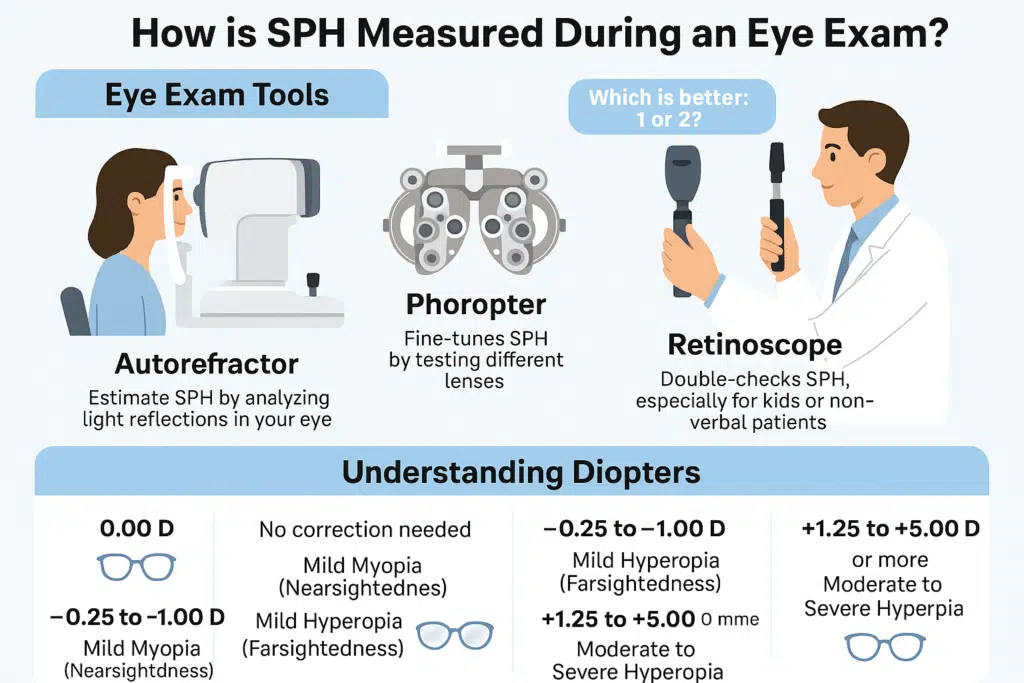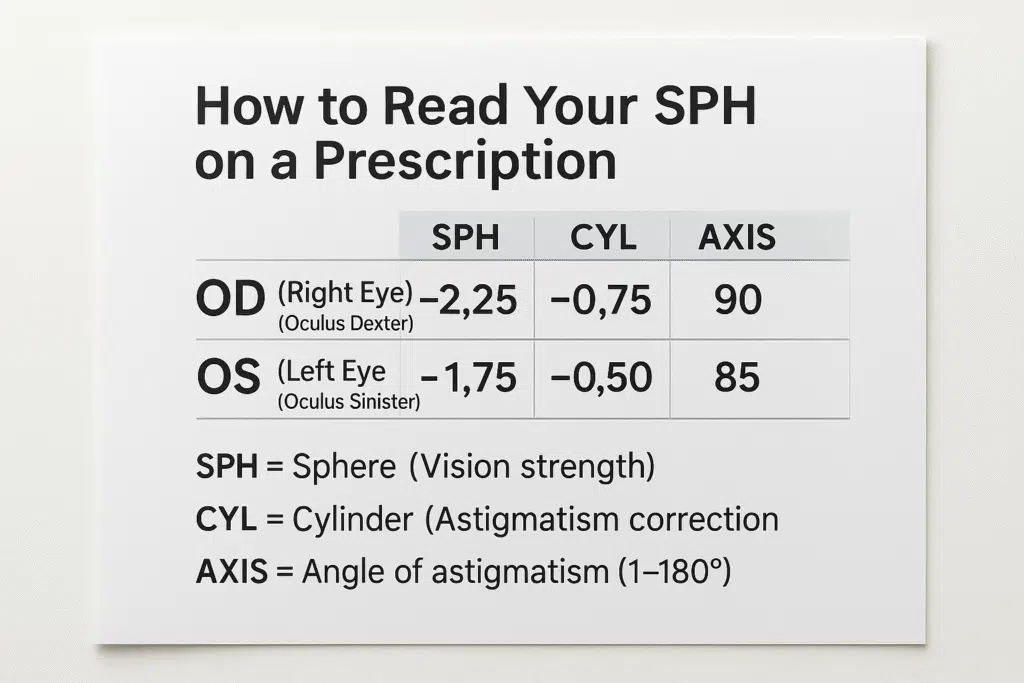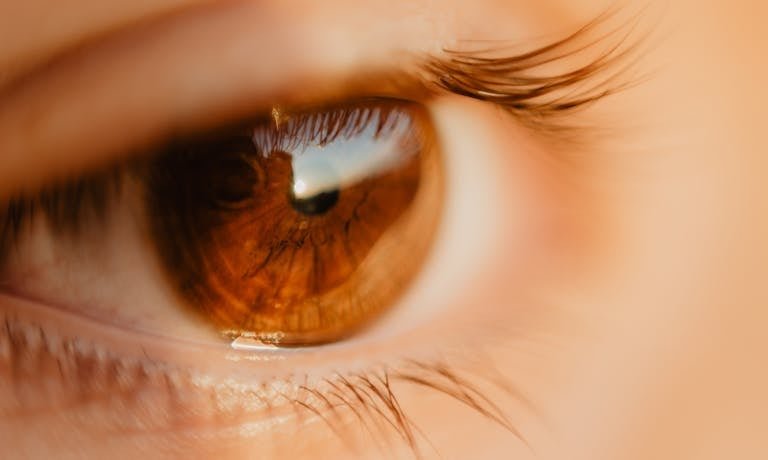SPH in Glasses Explained: What Your Prescription Means
Ever looked at your glasses prescription and thought What on earth does ‘SPH’ mean? Is it some secret code only eye doctors understand?
SPH, in simple terms, is used to check whether you are short-sighted or long-sighted and the strength that you require your lenses require so that you can see clearly. It is among the major constituents of your prescription, and being aware of it would enable you to decide better concerning your glasses, eyes, and even everyday comfort.
Here is this guide, which will inform you of everything you need to learn about SPH:
- What it means
- How it’s measured
- What a high or low SPH means for you
What Does SPH in Glasses Mean?
SPH stands for “Sphere.” Lens power in your glasses prescription is the number of corrections required in your sight, in diopters (D). To be more precise, it allows knowing whether you are nearsighted (myopia) or farsighted (hyperopia) and to what extent.
Types
- Negative (-) SPH: In case of seeing the minus sign in front of the number, you are said to be nearsighted (myopic). Objects that are close enough to you are quite visible, whereas distant objects are not that clear.
- Positive (+) SPH: The Plus sign means that you are farsighted (hyperopic). You could view an object that is of distance clearly than near objects.

How is SPH Measured?
SPH is done in the full eye check-up with different devices:
- Autorefractor: Tells you an approximation of your SPH by examining light reflection coming off your retina.
- Phoropter: The rotating lenses and futuristic-looking device allow the eye doctor to adjust your SPH by asking you to choose between 1 and 2.
- Retinoscope: Assists in verifying the measurement twice, in case of children or non-responsive in nature.
Read Also: Get Hunter Eyes: 4 Proven Ways That Actually Work
Diopters
The letter SPH is in 0.25 diopter steps. This is how it can be summed up:
- 0.00 D: You don’t need any correction (lucky you).
- -0.25 to -1.00 D: Mild nearsightedness.
- +0.25 to +1.00 D: Mild farsightedness.
- -1.25 to -5.00 D or more: Moderate or severe nearsightedness.
- +1.25 to +5.00 D or more: Moderate to severe farsightedness.
Diopter increment renders the amount of correction that your eyes require to bring things into focus. A discrepancy of 0.25 can easily be observed to make a difference in clarity.

SPH Values
Here’s how SPH values are typically categorized:
| SPH Range | Diopter Value | Vision Condition | Description |
|---|---|---|---|
| 0.00 D | None | Normal | No correction needed |
| -0.25 to -2.00 D | Mild | Nearsightedness | Blurred far vision (mild) |
| -2.25 to -5.00 D | Moderate | Nearsightedness | Moderately blurred far vision |
| -5.25 D and above | High | Nearsightedness | Severe distance vision issues |
| +0.25 to +2.00 D | Mild | Farsightedness | Blurred near vision (mild) |
| +2.25 to +5.00 D | Moderate | Farsightedness | Moderately blurred near vision |
| +5.25 D and above | High | Farsightedness | Significant difficulty with close-up tasks |
High SPH vs. Low SPH
Is my SPH score high or low? It is a good question. When I talk about vision health, I tend to divide this into each part, as your SPH can affect the type of lens you wear and your lifestyle significantly.
What Is Considered a Low SPH?
- From 0.00 to ±1.00 diopters
- It is commonly known as mild vision correction
- Does not necessarily have to wear glasses
- Mild SPH can continue to perform some roles perfectly without corrective glasses
Moderate SPH Range
- ±1.25 to ±3.00 diopters
- The readers in this range tend to require glasses on the majority of occasions
High SPH Range
- Above ±3.25 diopters
- Prescription is regarded as powerful
- You probably require glasses at all times
- Reduced thickness and weight of the lens might demand a special lens feature
Extreme SPH
- ±6.00 diopters and beyond
- You may need high-index lenses or customized frames
- The sight of sight may be very poor without glasses or contact lenses
The greater your SPH, the more it will affect your daily routine- the type of lens that you adopt to a general comfort and your field of view.
How to Read Your SPH on a Prescription
Here’s how your prescription might look:
| OD (Right Eye) | SPH: -2.25 | CYL: -0.75 | AXIS: 90 |
|---|---|---|---|
| OS (Left Eye) | SPH: -1.75 | CYL: -0.50 | AXIS: 85 |
- OD stands for “Oculus Dexter” = Right Eye
- OS stands for “Oculus Sinister” = Left Eye
When you simply have an SPH and no CYL or AXIS in your prescription, the script indicates that you do not have astigmatism.
Frequently Asked Questions (FAQs)
What is a normal eye SPH?
A normal SPH is 0.00, implying that no refracting is required. Any value near zero (+/- 0.25) points at very mild problems.
What do SPH and CYL mean?
SPH is used to treat myopia or hyperopia. CYL rectifies astigmatism caused by a malformed shape of the cornea.
What does SPH +0.25 mean?
It represents slight farsightedness. You also may not wear glasses all the time, but you can wear them to read or use a computer.
What does SPH +0.75 mean?
It means a bit higher farsightedness. Glasses will enhance near-range tasks and ease the strain on the eyes.
Read Also: What Are Deep-Set Eyes? How to Tell & Enhance Them
Final Words
One of them is SPH value, which is important when it comes to selecting the appropriate glasses and preserving sight. How to understand those numbers in the sense of reading the prescription. Regardless of the prescription you have, knowing the meaning of these numbers can help you make smarter and more confident choices.
Make sure that regular eye tests are carried out and that, in case of doubt, questions should be asked and that only the kind of lens you are actually in need of should be used.







